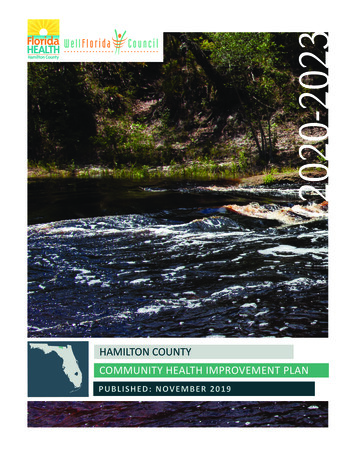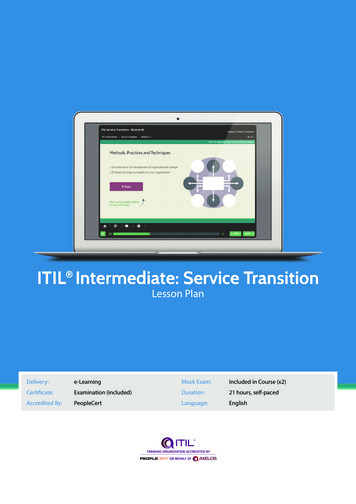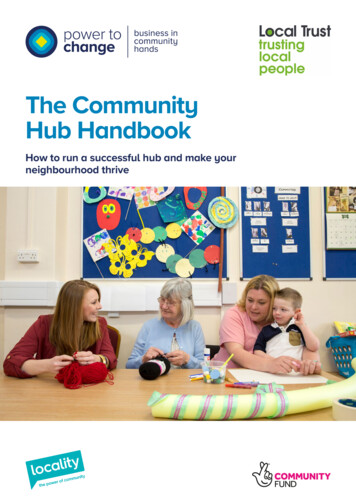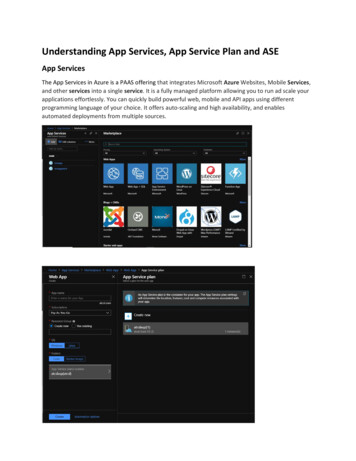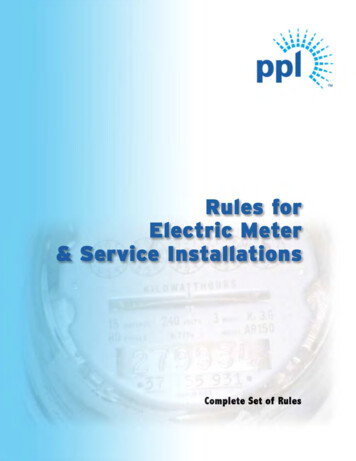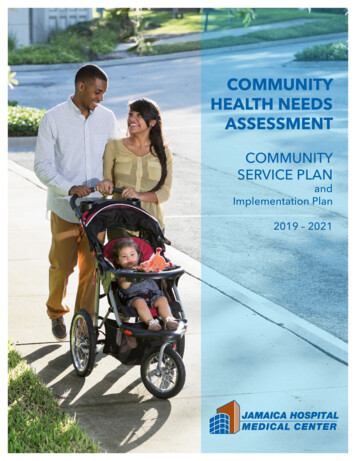
Transcription
COMMUNITYHEALTH NEEDSASSESSMENTCOMMUNITYSERVICE PLANandImplementation Plan2019 – 2021
TABLE OF CONTENTSEXECUTIVE SUMMARY . 1INTRODUCTION .Hospital Overview and Data Sources .JHMC’s Primary Service Area .Social Determinants of Health .Sharing Report with the Public .22477COMMUNITY HEALTH NEEDS ASSESSMENT .Community Statistics by Primary Service Area Neighborhood.Southwest Queens Neighborhood (Queens Community Districts 9 & 10) .Jamaica Neighborhood (Queens Community Districts 8 & 12) .East New York Neighborhood (Brooklyn Community Districts 4 & 5) .Community Statistics by New York State Prevention Agenda Priority Area .Priority Area I: Prevent Chronic Disease .Priority Area II: Promote a Healthy and Safe Environment.Priority Area III: Promote Healthy Women, Infants and Children .Priority Area IV: Promote Well-Being and Prevent Mental andSubstance Use Disorders.Priority Area V: Prevent Communicable Diseases .Community Health Survey Results .Background and Method .Population Characteristics.Neighborhood Health Issues .Hospital’s Interventions Addressing Top Health Issues .Changes to Improve Neighborhood Health.888111519192936COMMUNITY SERVICE PLAN .Selection of Prevention Agenda Priorities .JHMC Programs Addressing Top Community Health Issues .Criteria Used in Selection of Priorities for Community Service Plan .Using Hyper-local NYC Data in Communities with High Hospital Utilization .60606061624347555555575858IMPLEMENTATION PLAN . 63Prevent Chronic Diseases - Focus Area 3: Tobacco Prevention, Goal 3.2 - Promote TobaccoCessation .63Promote Healthy Women, Infants, and Children – Focus Area 2: Perinatal andInfant Health, Goal 2.2 – Increase Breastfeeding.67APPENDIX A – Survey Charts . A1-A15
EXECUTIVE SUMMARYThe effects of poverty on health, including difficulty obtaining nutritious food, unemployment, and theburden of high rents are observed in the communities that Jamaica Hospital serves, particularly in EastNew York, Brooklyn, and in pockets of Southwest Queens and Jamaica.Chronic diseases, obesity, tobacco use, behavioral health concerns, maternal morbidity, and late or noprenatal care were among the health issues highlighted in the community-level data analyses that JamaicaHospital conducted for this Community Health Needs Assessment (CHNA). These health concerns werealso identified by residents of the Hospital’s service area who responded to a health needs assessmentsurvey sponsored by the Hospital during the spring and summer of 2019. Many of these health problemsare caused in part by or exacerbated by the social determinants of health (SDH). The Hospital has begunfocused efforts to address SDH, including the effects of discrimination, as part of its treatment of thewhole person.Breastfeeding, which lowers the risk of death from infectious diseases in a child’s first two years of life,and can also reduce the risk of childhood obesity as well as the risk of a woman developing breast orovarian cancer, is still not practiced as often in parts of the Hospital’s service area as it is in New YorkCity overall. Jamaica Hospital has focused on improving rates of exclusive breastfeeding among thewomen giving birth in the Hospital and those attending its ambulatory care centers with their infants, aswell as among mothers in the community. The Hospital is designated as a Baby Friendly Hospital foroffering an optimal level of care for infant feeding and mother/baby bonding.Tobacco use and secondhand smoke, as well as household/outdoor air pollution, were identified asongoing community health concerns that are correlated with chronic disease, such as asthma and chronicobstructive pulmonary disease as well as cancer. Responding to the needs of the community, JamaicaHospital has focused on improving tobacco cessation rates. The Hospital was awarded Gold Star Statusfrom the NYC DOHMH’s Tobacco-Free Hospitals Campaign in recognition of its tobacco cessationprogramming and successes, and continues to comply with the Campaign’s standards.With the benefit of community input, the Hospital has chosen to highlight the prevalence of these twohealth issues in its service area as well as the Hospital’s concerted efforts to address them in its three yearcomprehensive Community Service Plan and Implementation Plan. These initiatives are in alignmentwith the NYS Prevention Agenda Priorities and the Healthy People 2020 goals.Full report can be obtained on the Hospital’s website: 1 of 70
INTRODUCTIONHospital Overview and Data SourcesJamaica Hospital Medical Center (JHMC), founded in 1891, is a not-for-profit 402-bed, Article 28licensed facility located close to LaGuardia Airport, the John F. Kennedy International Airport, andseveral major highways (Van Wyck Expressway, Long Island Expressway, and Grand Central Parkway).The surrounding neighborhoods are culturally diverse, densely populated, urban areas of southern Queensand East New York, Brooklyn. JHMC’s primary service area (PSA) spans 36.3 square miles, coveringthe Queens neighborhoods of Jamaica and Southwest Queens (SWQ), as well as the Brooklynneighborhood of East New York (ENY), which are home to 784,840 (2018) people.The Hospital annually cares for approximately 19,627 inpatients including 1,681 newborns, 110,299emergency department patients, and 336,725 ambulatory care patients. It offers a full array of general andspecialty medical and surgical care; acute inpatient; emergency services (including its Level I TraumaCenter and Primary Stroke Center; rehabilitation; pediatric; and psychiatric services (including itsComprehensive Psychiatric Emergency Program); ambulatory surgery. The Hospital is a NYS-designatedLevel 3 Perinatal Center with a Level III neonatal intensive care unit (NICU) and a WHO-designatedBaby Friendly Hospital. The ambulatory care program provides a full range of medical and dentalservices on and off campus at nine PCMH-recognized Family Care Centers as well as three school basedhealth centers.JHMC is part of an integrated health care delivery system, MediSys Health Network, which includesFlushing Hospital in northern Queens, The Jamaica Hospital Nursing Home, located on the Hospital’scampus, and a large multi-specialty physician group practice with offices on campus and in thecommunity.The Hospital’s mission is To serve our patients and the community in a way that is second to none.This Community Health Needs Assessment (CHNA) will examine the needs of the residents of theseneighborhoods. Community health data describing JHMC’s PSA population will be presented usingquantitative public data from the New York City Department of Health and Mental Hygiene (DOHMH)and qualitative data obtained from residents in JHMC’s community health needs survey. Othercommonly used data sources include the New York State Department of Health and the U.S. CensusAmerican Community Survey. Following the presentation of CHNA data for Jamaica, Southwest Queens(SWQ), and East New York (ENY), results of a CHNA survey in JHMC’s service area will be discussed.New York City (NYC) has different ways of describing and categorizing neighborhoods, which isrelevant to how community health data are analyzed and presented. Neighborhoods are typically definedaccording to either NYC Community Districts or United Health Fund neighborhoods (an independent,nonprofit, health services research and philanthropic organization). There are 59 NYC CommunityDistricts, which were established by local law in 1975. United Health Fund (UHF) neighborhoods consistof 34 neighborhoods, made up of adjoining zip code areas, designated to approximate NYC CommunityPlanning districts. JHMC’s Primary Service (PSA) has traditionally been defined as covering the Queensneighborhoods of Jamaica and SWQ, as well as the Brooklyn neighborhood of ENY. Theseneighborhoods, as defined by the UHF, do not correspond exactly to distinct Community Districts, asshown in the table and map on the following pages.2 of 70
INTRODUCTIONJHMC’s service area was determined by analyzing Statewide Planning and Research Cooperative System(SPARCS) 2017 discharge data at the zip code level. The UHF neighborhoods with the highest volumesof patients were determined to be the PSA. UHF neighborhoods with at least 3% of inpatient cases wereconsidered the hospital’s secondary service area (SSA) The PSA and SSA together account forapproximately 86% of the Hospital’s total inpatient cases, with the PSA accounting for 78% and the SSA8%. The JHMC CHNA focuses on the Hospital’s PSA.Most of the data in this report reflect JHMC’s service area data from the NYC Department of Health andMental Hygiene’s Community Health Profiles (2018) and the most recent years’ Community HealthSurveys. Data from other than these two sources will be footnoted. As the Community Health Profile dataare organized by Community District, and the Community Health Survey data are organized by UHFneighborhood, JHMC has used both ways to describe neighborhoods. Additionally, the New York StateDelivery System Reform Incentive Payment (DSRIP) Program’s data, were aggregated into UHFneighborhoods and analyzed to better capture and describe JHMC’s service area.3 of 70
INTRODUCTIONJHMC’s Primary Service AreaThe PSA covers three UHF neighborhoods – Jamaica (408), Southwest Queens (407) and East New York(204). These three neighborhoods lie within two boroughs and multiple community districts as shown inTable 1.Table 1: JHMC PSA: Community District and UHF Neighborhood Crosswalk and Percent ofInpatient DischargesZip Code % of Discharges,Community DistrictUHFNeighborhood/(Code)114122%Jamaica and Hollis (12)Jamaica (408)114143%South Ozone Park and Howard Beach (10)Southwest Queens(407)114152%Kew Gardens and Woodhaven (9)Southwest Queens(407)114164%Kew Gardens and Woodhaven (9)Southwest Queens(407)114174%South Ozone Park and Howard Beach (10)Southwest Queens(407)114187%Kew Gardens and Woodhaven (9)Southwest Queens(407)114198%Kew Gardens and Woodhaven (9),Southwest QueensSouth Ozone Park and Howard Beach (10)(407)114206%South Ozone Park and Howard Beach (10)Southwest Queens(407)114215%Kew Gardens and Woodhaven (9)Southwest Queens(407)114231%Hillcrest and Fresh Meadows (8),Jamaica (408)Jamaica and Hollis (12)114301%None (John F. Kennedy InternationalJamaica (408)Airport; residential population 1841)114324%Hillcrest and Fresh Meadows (8)Jamaica (408)Jamaica and Hollis (12)114335%Jamaica and Hollis (12)Jamaica (408)114347%Jamaica and Hollis (12),Jamaica (408)Queens Village (13)114357%Hillcrest and Fresh Meadows (8)Jamaica (408)Jamaica and Hollis (12)114364%Jamaica and Hollis (12)Jamaica (408)112072%Bushwick (4),East New York (204)East New York and Starrett City (5)112089%East New York and Starrett City (5)East New York (204)78%Total PSA1US. Census. 2010 Demographic Profile. Factfinder.census.gov4 of 70
INTRODUCTIONFigure 1. Jamaica Hospital Medical Center’s Service AreaUnited Health Fund (UHF) and CommunityDistrict Overlay of JHMC’s Primary Service Area:White outlines mark the Community Districts.White numbers note Brooklyn CommunityDistricts. Green numbers note QueensCommunity Districts. Black numbers and linesdefine UHF neighborhoods. The green dashedline marks JHMC’s PSA, which contains UHFareas 204 (ENY), 407 (SWQ), and 408 (Jamaica).The ‘H’ signifies the location of JHMC.There are gaps in primary medical care, including dental care and mental health care across Queens,which are also evident in JHMC’s service area. Queens has seven neighborhoods that are designated asMedically Underserved Areas (MUA) by the Health Resources and Services Administration (HRSA) 2;this designation is based on four factors: the ratio of primary medical care physicians per 1,000population, infant mortality rate, percentage of the population with incomes below the poverty level, andpercentage of the population age 65 or over. The Kings Service Area MUA, which contains East NewYork, and the Queens Service Area MUA, which contains parts of Jamaica, cover JHMC’s service area.South Jamaica, a neighborhood within JHMC’s primary service area, also is a designated MUA. SouthJamaica is also designated as a Primary Care Health Professional Shortage Area (HPSA) by HRSA,meaning there are less primary care professionals than are necessary to accommodate the populationliving in that area. Census tracts within South Jamaica are also designated as Mental Health HPSAs,meaning there are less mental health care professionals than are necessary to accommodate thepopulation living in those areas. Within JHMC’s service area, there are two facilities (Joseph P. AddabboFamily Health Center and Project Samaritan Health Services) that received Mental Health HPSAdesignation because they provide mental health services to an area or population group designated ashaving a shortage.The Hospital also offers primary care at eight community-based extension clinics in Southwest Queensand Jamaica, which provide pediatric primary care services and are NCQA NYS 2018 PCMHrecognized: MediSys – ENY, MediSys – Jamaica, MediSys – Hollis, MediSys – Hollis Tudors, MediSys– St. Albans, MediSys – Richmond Hill, MediSys – Ozone Park (Medwise/Clocktower), and MediSys –Howard Beach. In addition, the Hospital provides ambulatory services at its Women's Health Center,Family Dental Center, Mental Health Center, Sleep Center and affiliated Advanced Center forPsychotherapy. Services are also provided by the Hospital at three public schools: PS 155 (Elementary2HRSA Find. Data.HRSA.gov. 5 of 70
INTRODUCTIONSchool), PS 223 (Elementary School) and Campus Magnet High School. In Queens there are eight acutecare hospitals including affiliated Flushing Hospital Medical Center (FHMC), 12 nursing homes, and 48HRSA-supported Federally Qualified Health Centers (FQHC) or Look-Alikes that provide services inQueens County and nearby Brooklyn zip codes.3 Three other acute care hospitals serve the communitieswithin JHMC’s PSA: Northwell Health Long Island Jewish Forest Hills Hospital and Long Island JewishMedical Center, and Health Hospitals/Queens Hospital Center. There are also many diagnostic andtreatment centers, as well as numerous physician group practices, and individual physician offices thatalso serve this area.Inpatient psychiatric care is provided at JHMC and at affiliated FHMC and at six other licensed facilitiesin Queens. In addition, there are 51 outpatient mental health services including those at JHMC andFHMC, support programs, emergency services, and residential facilities that provide mental healthtreatment to adults and children. 4 Creedmoor Addiction Treatment Center, a state-operated facility, servesQueens and the rest of New York City. Thirty-three chemical dependency treatment agencies includingthe inpatient detoxification unit and outpatient Reflections clinic at FHMC, and 63 individual providersin Queen provide chemical dependency prevention/treatment and impaired driving offender programs. 5Approximately 240 DATA-waivered practitioners in Queens are certified to provide buprenorphinetreatment of opioid use disorder.63HRSA Data Warehouse. Health Centers and Look-alike Sites Site Directory. Accessed ts/OneClickRptFilter.aspx?rptName FAHCSiteList4NYS OMH. Mental Health Program Directory. Accessed online 6/14/2019: S OASAS. Accessed online 6/14/2019. fm6SAMHSA. Buprenorphine Practitioner Locator. Access online 6/14/2019: -locator6 of 70
INTRODUCTIONSocial Determinants of Health (SDH)Social Determinants of Health (SDH) are defined by Healthy People 2020 as the conditions in theenvironments in which people are born, live, learn, work, play, worship, and age that affect a wide rangeof health, functioning, and quality-of-life outcomes and risks. These conditions can affect a wide range ofhealth risks and outcomes. The five key social determinants of health (SDH) domains include: Economic stability; Education; Social and community context; Health and health care; and Neighborhood and environment.Integrating health and human services to address SDH can have a significant impact on health outcomes. 7Jamaica Hospital Medical Center will integrate SDH into its approach to address the Prevention AgendaPriority Areas identified by the New York State Department of Health in its Prevention Agenda 2019-24:I. Prevent Chronic Disease;II. Promote a Healthy and Safe Environment;III. Promote Healthy Women, Infants, and Children;IV. Promote Well-Being and Prevent Mental and Substance Use Disorders; andV. Prevent Communicable Diseases.Within each Priority Area, Jamaica Hospital analyzed and summarized data relevant to “focus areas”(e.g., “reduce obesity” and “reduce illness, disability, and death related to tobacco use and secondhandsmoke exposure”, which are focus areas for the Prevent Chronic Disease priority). Data were primarilyobtained from the New York City Department of Health and Mental Hygiene’s (NYC DOHMH) 2018Community Health Profiles and Community Health Surveys (EpiQuery); the New York State Departmentof Health’s Delivery System Reform Incentive Payment (DSRIP) Program’s clinical metrics andperformance data; and community-wide surveys that were administered as part of data collection for the2014 Queens Community Needs Assessment (CNA). 2019 CHNA survey results from a recent surveysponsored by JHMC are discussed in a subsequent section.Sharing Report with the PublicThe full report was distributed to the members of the Hospital's Board of Trustees, who approved it onNovember 25, 2019. Announcement of the report’s availability will be posted on the Hospital’s socialmedia platforms. A copy can be obtained from the Hospital’s ice-plan7NYS Department of Health. Social Determinants of Health and Community Based Organizations. retrieved May 8, 2019https://www.health.ny.gov/health care/medicaid/redesign/sdh/index.htm7 of 70
COMMUNITY HEALTH NEEDS ASSESSMENTNote: Most of the charts in this report reflect JHMC’s service area data from the NYC Department ofHealth and Mental Hygiene’s Community Health Profiles and Community Health Surveys. As theCommunity Health Profile data are organized by Community District, and the Community HealthSurvey and DSRIP data are organized by UHF neighborhood, JHMC has used both ways to describeneighborhoods and provide a snapshot of the population characteristics.Community Statistics by Primary Service Area NeighborhoodSouthwest Queens Neighborhood (Community Districts 9 & 10)DemographicsThe total resident population of Southwest Queens is approximately 278,085 (2018) with a 2.2%increase projected in the next five years. Twenty-two percent of residents are age 17 and under, 16%are over 65 years. There are an estimated 58,000 females of childbearing age (15 to 44 years). 8Overall, the population of 278,085 residents is diverse. A third of Southwest Queens residents areHispanic/Latino (33.5%; regardless of race; 23.1% are Asian and Pacific Islander; 18.7% are Whitenon-Hispanic; and 12.4% are Black. All others, including mixed race, comprise 12.3%. 9 Half (50.5%)of Kew Gardens and Woodhaven residents are foreign born; 45.9% of South Ozone Park and HowardBeach residents are foreign born.10 Richmond Hill, a community known for its large Indo-Guyanese,Indo-Trinidadian and Tobagonian, and Indo-Caribbean immigrant population, as well as Little Punjab,for its large Punjabi immigrant population, has the highest percentage of foreign born residents inSouthwest Queens, 55%.11Social and Economic StressorsIn Kew Gardens and Woodhaven: 22% of residents live in poverty, compared with 19% of Queensoverall and 20% in NYC. In South Ozone Park and Howard Beach, 19% of residents live in poverty.Housing and EmploymentSouth Ozone Park and Howard Beach’s unemployment rate (10%) is higher than the citywide averageof 9%. Fifty-six percent of South Ozone Park and Howard Beach residents are rent burdened, a higherrate than residents citywide. Unemployment rates in Kew Gardens and Woodhaven are similar to therest of NYC. More residents are rent burdened (55%), higher than the rest of Queens (53%) and 51%city wide. Overcrowded housing conditions ( 1 person/room) are less prevalent in Southwest Queens(8.8%) than in NYC (9.0%) or Queens (10.4%).12EducationTwenty-three percent of South Ozone Park and Howard Beach residents over 25 years have notcompleted high school, compared with 19% in both Queens and NYC; Kew Gardens and Woodhavenhave similar rates to Queens and NYC.8Claritas Company, Demographics Snapshot, 2018Ibid.10Neighborhood Health e11Haller, Vera (January 11, 2013). "Living in Richmond Hill: Indo-Caribbean Content, Victorian Style". The New YorkTimes.12NYC Environmental & Health Data Portal. tracking.aspx8 of 709
COMMUNITY HEALTH NEEDS ASSESSMENTCrimeKew Gardens and Woodhaven residents have lower rates of incarceration (345/100,000) than NYC(425/100,000) in general, but higher rates than the rest of Queens (315/100,000). Aggregate rates forSouth Ozone Park and Howard Beach (381/100,000) follow a similar pattern. Assault-relatedhospitalizations in Kew Gardens are lower (43/100,000) than in Queens overall (37/100,000), SouthOzone Park (32/100,000), and NYC (59/100,000).HealthSeventy-seven percent of South Ozone Park and Howard Beach residents rank their health as“excellent,” “very good”, or “good”, similar to the rest of NYC (78%). Seventy-eight percent of KewGardens and Woodhaven residents rank their health as “excellent”, “very good”, or “good”.Access to Health CareCitywide, the percentage of uninsured New Yorkers decreased in the last five years, from 20% to 12%.In Kew Gardens and Woodhaven, 15% of adults are uninsured and 7% report going without neededmedical care in the past 12 months, similar to the rest of NYC. In South Ozone Park and HowardBeach, 8% of adults are uninsured, similar to the rest of NYC, and 7% report going without neededmedical care in the past 12 months, lower than the rest of NYC. Overall, 20.8% of residents receiveMedicaid and 11.2% are uninsured in SW Queens while 48% are privately insured.NutritionThere are no farmers markets in Kew Gardens and Woodhaven. The supermarket to bodega ratio is1:11, limiting access to fresh food. In Ozone Park and Howard Beach, the supermarket to bodega ratiois 1:8; however, there are no farmers’ markets available there, as well. More Southwest Queensresidents (24.7%) report drinking at least one sugary drink a day, compared to Queens (21.4%) andNYC (23%) residents. In Southwest Queens 8.7% of residents reported they sometimes/often did nothave enough food, lower than the other neighborhoods in JHMC’s service area.SmokingIn Ozone Park, the current smoking rate reported is 12.7%, lower than the NYC rate (13.4%), Yet, therate of “former smoker” (20.4%) was higher than the NYC rate (18.4%), indicating success in smokingcessation efforts over time. The Kew Gardens rate was lower (11%) compared to 14% for Queens andNYC at large. Overall, in Southwest Queens 44% began smoking between the ages of 13 to17 years,22.1 % began between the ages of 18 to 20 years, and 22% began over the age of 21 years. Threepercent began when they were less than 12 years old.HIVOver one third (35.2%) of Southwest Queens residents reported they had been tested for HIV in the last12 months; while 35.8% reported they had never been tested. In 2017, incidence in Southwest Queen,16.1/100,000 population, was below the Queens (26.1/100,000) and NYC (25.3/100,000).1313NYC DOHMH. NYC HIV/AIDS Surveillance Statistics 2017.9 of 70
COMMUNITY HEALTH NEEDS ASSESSMENTVaccinationsForty-seven percent of teens ages 13 to 17 years in South Ozone Park and Howard Beach received allrecommended doses of the HPV vaccine in 2016.14 Thirty-eight percent of South Ozone Park andHoward Beach adults report getting a flu vaccine in the same period, slightly less than the rest of NYC.Child HealthKew Gardens and Woodhaven have slightly higher rates of childhood obesity (22%) than South OzonePark and Howard Beach (21%) Queens and the rest of NYC (20% in each community). Childhoodhospitalization rates in Kew Gardens and Woodhaven (816/100,000) are higher than South Ozone Parkand Howard Beach (656/100,000) and Queens (461/100,000).15 Among children in Southwest Queenstested for elevated blood lead levels, 19.7% had over 5 mcg/dL or greater, compared to 14.3% inQueens overall and 16.5% in NYC.16Adult ObesityIn Southwest Queens, 29.8% of adults are overweight, lower than the rates for Queens (34.1%) andNYC (32.2%). In contrast, obesity rates in Southwest Queens (30.2%) are higher than for Queens(23.7% and NYC at large (25.1%).Physical ActivityIn 2017, 71.1% of Southwest Queens residents reported some physical activity in the past 30 days, lessthan Queens (74%) and NYC (74.5%).Chronic DiseaseThe diabetes rate in Southwest Queens is 14%, compared to both Queens and NYC at 11.5%.Hypertension rates are similar to that of Queens and NYC– 29% versus 27% in Queens and 28% inNYC.Prenatal CareOverall 6.8% of pregnant women in NYC had late (beginning third trimester) or no prenatal care,compared to Queens (8.2%) and Brooklyn (6.1%). South Ozone Park and Howard Beach (9.0%) andKew Gardens and Woodhaven (8%) had higher rates of late or no prenatal care. In NYC, 13% of Blackwomen, 7% of Hispanic, and 5% of Asian women received late or no prenatal care compared to 3.1%of White women.17Avoidable HospitalizationsThe rate of avoidable hospitalizations among adults in South Ozone Park and Howard Beach(1,181/100,000) is similar to Kew Gardens and Woodhaven (1,183/100,000). However, bothcommunities have higher avoidable hospitalization rates than in Queens (1,028/100,000) and NYC(1,033/100,000).14HPV Vaccination: NYC DOHMH, Citywide Immunization Registry, 2017.Avoidable Hospitalizations among Children: New York State Department of Health, Statewide Planning and ResearchCooperative System (2014) as reported in NYC Community Health Profiles 2018.16Keeping Track Online: Citizen’s Committee for Children (2016 data).17Keeping Track Online: Citizen’s Committee for Children. no-prenatalcare#1271/1470/22/a/a10 of 7015
COMMUNITY HEALTH NEEDS ASSESSMENTPremature DeathIn South Ozone Park and Howard Beach, the collective premature death rate is slightly lower than therest of NYC (154.6/100,000 versus 169.5/100,000, respectively). This lower rate is due primarily toless cancer or drug related deaths. In Kew Gardens, the premature death rate is (137.9/100,000). Thethree leading cases of cancer-related premature death in Kew Gardens are lung, breast, and colorectalcancer. Heart disease is the second leading cause of death at 30.4/100,000. Residents in Kew Gardenshave a life expectancy of 82.9 years, 1.7 years longer than NYC overall. South Ozone Park and HowardBeach’s life expectancy is 81.7 years.Mental HealthNew York City residents reported a rate of current depression of 9.3%; higher than the overall Queensrate of 7.7%, but lower than the rates in both East New York (10.9%) and Jamaica (12.0%). The rate ofadult psychiatric hospitalization in Kew Gardens (479/100,000) and South Ozone Park (488/100,000)are lower than the Queens’ rate (513/100,000) and that of NYC (676, 100,000).18Jamaica Neighborhood (Queens Community Districts 8 & 12)DemographicsThe total population of Jamaica in 2018 was 303,163 residents with a 2
relevant to how community health data are analyzed and presented. Neighborhoods are typically defined according to either NYC Community Districts or United Health Fund neighborhoods (an independent, nonprofit, health services research and philanthropic organization). There are 59 NYC Communit





